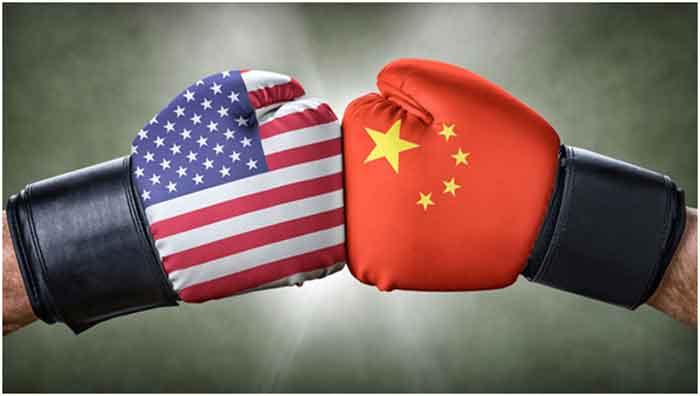
Like his immediate predecessor, Joe Biden is committed to a distinctly anti-China global strategy and has sworn that China will not “become the leading country in the world, the wealthiest country in the world, and the most powerful country in the world… on my watch.” In the topsy-turvy universe created by the Covid-19 pandemic, it was, however, Jamie Dimon, the CEO and chairman of JP Morgan Chase, a banking giant with assets of $3.4 trillion, who spoke truth to Biden on the subject.
While predicting an immediate boom in the U.S. economy “that could easily run into 2023,” Dimon had grimmer news on the future as well. “China’s leaders believe that America is in decline,” he wrote in his annual letter to the company’s shareholders. While the U.S. had faced tough times in the past, he added, today “the Chinese see an America that is losing ground in technology, infrastructure, and education — a nation torn and crippled by politics, as well as racial and income inequality — and a country unable to coordinate government policies (fiscal, monetary, industrial, regulatory) in any coherent way to accomplish national goals.” He was forthright enough to say, “Unfortunately, recently, there is a lot of truth to this.”
As for China, Dimon could also have added, its government possesses at least two powerful levers in areas where the United States is likely to prove vulnerable: dominant control of container ports worldwide and the supplies of rare earth metals critical not just to the information-technology sector but also to the production of electric and hybrid cars, jet fighters, and missile guidance systems. And that’s only a partial list of the areas where China is poised to become dominant in the foreseeable future. Here’s a likely scenario.
The Digital Yuan Versus the (Missing) Digital Dollar
Within the broad headline of the globe’s “second-largest economy,” China has already either surpassed the United States or is running neck-and-neck with it in certain specific sectors.
With a global smartphone market share of 20% in the second quarter of 2020, China’s Huawei Technologies topped the charts, marginally exceeding South Korea’s Samsung, and well ahead of Apple, according to the International Data Corporation. This happened despite a concerted drive by President Donald Trump’s administration to damage Huawei that culminated, in May 2020, with Washington barring companies worldwide from using U.S.-made machinery or software to design or produce chips for that company or its entities from that September on. Nonetheless, with a 47% share of China’s booming 5G smartphone market, Huawei topped the list there while it kept up its investment in future-oriented, cutting-edge technologies and basic research to the tune of a striking $3 billion to $5 billion annually.
Broadly speaking, China continues to make impressive strides when it comes to developing its information and communications technology sector. Its Fintech (Financial Technology) report, published in October 2020, showed that an estimated 87% of Chinese consumers used fintech services. With a vast mobile-payment system that hit $29 trillion (200 trillion yuan) worth of payments in 2019, China is shaping up to become the globe’s first “cashless society” and its largest financial-technology ecosystem by the end of this decade.
Less than 10% of Americans use mobile payments, which means a similar scenario for the United States is nowhere on the horizon. With mobile transactions in China already accounting for at least four out of every five payments and more than half the value of all non-cash retail payments, that country is poised to leave the U.S., a comparative laggard in fintech, shackled to a cash-dominated system.
In their relentless drive for innovation, the Chinese authorities started pushing the development of a digital currency in certain regions in August 2020. Their specific goals were to make daily life easier for citizens and digital payments more secure. While non-bank payment platforms like Alipay and WeChat Pay required users to link to bank accounts, a digital wallet with an e-currency deposit could be opened with a unique personal identification — a driver’s license or a mobile phone number — enabling the un-banked population of China to embrace the digital world.
As a result, the People’s Bank of China became the first major central bank to issue a virtual currency. A broader roll-out is expected for the Winter Olympics in Beijing in February 2022, which will give the digital yuan international exposure.
This has alarmed the Biden administration. Officials at the Treasury Department, the State Department, the Pentagon, and the National Security Council are frantically trying to comprehend the potential implications of a virtual yuan system. They are particularly eager to understand how it would be distributed, and whether it could be used to bypass Washington’s international sanctions as applied to Iran. What distresses some American officials and experts is the notion that someday China’s virtual yuan could replace the U.S. dollar as the world’s dominant reserve currency.
At the Federal Reserve, Chairman Jerome Powell insisted that the central bank was involved in a large-scale research and development project on a possible future digital dollar, though pointing out that such a project could only be launched via a law that would have to be passed by a deeply divided Congress. In short, irrespective of the future of China’s virtual currency, a digital dollar is not likely, not in the near future anyway.
Building Infrastructure (or Not)
As for recent economic history, even a cursory look at the performances of the United States and China in combating the 2008 financial meltdown tells a striking tale.
China made an indelible mark in meeting that financial challenge. Its government sharply increased its infrastructure spending, resulting in higher imports that helped counter flagging global demand. While this move increased Beijing’s debt, it also helped build a foundation to further transform the country’s economy into a productivity-led growth model. A decade after that great recession, according to the World Economic Forum’s Global Competitiveness Report, China’s infrastructure ranking jumped from 66th place to 36th place out of 152 countries.
Although infrastructure building on a large scale requires significant upfront investment, it’s guaranteed to yield productivity gains in the long run. Time and cost savings for commuters, improved market access, healthier competition, increased exchange of ideas, and enlarged innovation capacity, all aided by modern infrastructure, are a springboard for economic development.
During the decade following the 2008 crisis, the number of Chinese cities with metro services jumped from 10 to 34 and 1.1 million kilometers of highways were built, raising the total to 4.8 million kilometers. The length of its high-speed rail system shot up by 52,000 kilometers to 132,000 kilometers. Introduced on the eve of the 2008 Olympics in Beijing, it’s now by far the world’s longest system, accounting for two-thirds of the globe’s high-speed rail. Its advances in information-and computer-technology were equally impressive. On average, mobile-phone subscriptions came to exceed one per person — about the same as in the United States.
High-speed rail (of which the United States has none) reduces journey times, while linking dense urban areas with less crowded cities. In doing so, it allows for a more balanced distribution of labor and business development without sacrificing the benefits of an increasingly urbanized economy. Economies of scale in turn mean that productivity rises as rail usage increases.
Little wonder, then, that President Barack Obama and his team promoted the $787 billion American Recovery and Reinvestment Act of 2009 as an infrastructure-building program in response to the 2008 economic crisis. In reality, however, only $80 billion, a tenth of the money Congress sanctioned, would be devoted to actual infrastructure. Of that, about a third was spent on roads and bridges, improving about 67,600 kilometers of roads and 2,700 bridges. The program also included investment in modern infrastructure like smart grids and broadband development.
In 2010, Obama announced what was to be the “largest investment in infrastructure since the Interstate Highway System,” the creation of a high-speed rail network that would rival China’s. More than a decade later, the only visible progress is a much-delayed and still incomplete 275-kilometer Central Valley California line from Bakersfield to Merced. And in the Trump years, when essentially no government money went into such projects, “infrastructure week” became a standing joke. President Biden seems determined to rectify this, but how successful he’ll be with his $2 trillion infrastructure proposal in the face of a rigidly divided Congress remains to be seen.
For its part, the Chinese government combined its program of rapid infrastructure development with upgrading of the labor force. It did so by implementing an educational system that stressed science, technology, engineering, and math, known as STEM. By achieving higher productivity in this way, the government planned to compensate for a projected shrinkage in its work force.
To promote STEM, the government issued guidelines in 2016 to create a national development strategy aimed at advancing China to the forefront of innovative countries by 2030. In February 2017, the Ministry of Education officially added STEM education to the primary-school curriculum. Since then, encouraged by official policies, schools in both the public and private sectors have implemented such programs.
In 2019, the government allocated 100% of its research funding to top universities to the ones that concentrated on STEM disciplines. By comparison, South Korea allocated 62% of such funding that way. By contrast, U.S. universities ranked in the top 100 maintained a greater balance in funding among STEM fields, humanities, and social sciences.
In October 2019, three of China’s biggest mobile-phone carriers launched advanced 5G services, giving it the world’s largest 5G mobile network. A year later, the Wall Street Journal reported that China had more 5G subscribers than the U.S., not just in total but per capita.
Given the ubiquity of smartphones, the news that America seemed to be losing the tech race to China was widely noted. Mostly ignored, however, was the extent to which the U.S. had become vulnerable to Chinese pressure in international trade.
America’s Vulnerabilities
In testimony before Congress in October 2019, Carolyn Bartholomew, chairwoman of the U.S.-China Economic and Security Review Commission, revealed that at least two-thirds of the world’s top 50 maritime container ports were directly owned and managed by the Chinese or supported by that country’s investments (up from roughly 20% a decade ago). These included terminals at major American container ports in Los Angeles and Seattle. When it came to such ports, it led the world with seven of the 10 largest ones.
A year earlier, officials at the state-owned China Ocean Shipping Company, one of the globe’s largest container shipping lines, acknowledged that the company had connected its routes along what was officially called the Maritime Silk Road, linking regional markets in West Africa, Northern Europe, the Caribbean, and the U.S. to form a more comprehensive and balanced globalized trading network. “By owning and/or operating a network of logistical nodes across Asia, Europe, and Africa, China can control a significant portion of its inbound supply chain for essential commodities and outbound trade routes for its exports,” Bartholomew explained. “In the event of conflict, China could use its control over these and other ports to hinder trade access to other countries.”
In the manufacturing sector, China finds itself in a privileged position by virtue of its special mineral deposits, called rare earth elements. A group of 17 rare earth metals, including lanthanum, cerium, yttrium, europium, and gadolinium, often called “industrial gold,” are critical components of such high-technology and clean-energy products as wind turbines, solar panels, and electric cars, because of their magnetism, luminescence, and strength. They are also used in a wide variety of weapons from jet fighters to nuclear submarines.
Unsurprisingly, in recent years, there has been a rapid rise in the demand for these minerals in advanced economies. They are dispersed in low concentrations and are costly to extract from ore, an industry in which China has invested a great deal since the 1970s.
According to the U.S. Geological Survey, in 2020, China accounted for 58% of rare earth minerals production, down from around 90% four years earlier, as the United States and Australia boosted their own mining of them. Still, as of 2018, the United States imported 80.5% of its rare earth metals from China. In May of that year, the Trump administration added these to a list of minerals deemed critical to American economic and national security. And in July 2019, it declared them “essential to the national defense,” which freed up resources for the Department of Defense to take action to secure a domestic rare earth production capability.
Even if the mining of these ores increased in the U.S., refining them requires specialist technology and trained personnel as well as high upfront investment. Due to the lack of these in the U.S. so far, China continues to enjoy a near monopoly in processing the ore, with the raw material containing the prized metal mined outside China shipped to the Chinese sites. The refining process also generates large amounts of radioactive waste and pollutes the environment. As a result, developed countries usually opt for getting the refining done in emerging economies.
All in all, when you view the globe in the throes of a once-in-a-century pandemic, you find an authoritarian state, wedded to centralized planning, initiating programs with long-term benefits for its citizens and seeing them through. You also see a politically riven democratic republic operating primarily on an ad hoc basis.
The stark truth is that an American president cannot even bet on his policies, however laudable or otherwise, surviving his four-year term. Trump’s succession after the Obama era illustrated this dramatically, as has that of Trump’s successor, Biden. When judged purely on the basis of final results, centralized planning clearly beats short-term programming, even if it is viewed with a mixture of derision and condemnation by the Western governments that Biden is attempting to coopt to challenge China. The reality of our moment: that country is now rising on a distinctly wounded planet.
Follow TomDispatch on Twitter and join us on Facebook. Check out the newest Dispatch Books, John Feffer’s new dystopian novel Frostlands (the second in the Splinterlands series), Beverly Gologorsky’s novel Every Body Has a Story, and Tom Engelhardt’s A Nation Unmade by War, as well as Alfred McCoy’s In the Shadows of the American Century: The Rise and Decline of U.S. Global Power and John Dower’s The Violent American Century: War and Terror Since World War II.
















































